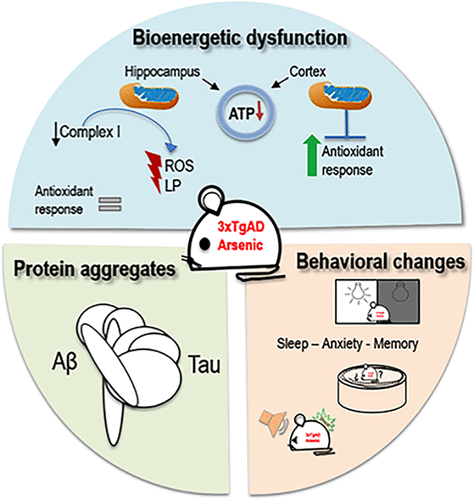当前位置:
X-MOL 学术
›
ACS Chem. Neurosci.
›
论文详情
Our official English website, www.x-mol.net, welcomes your
feedback! (Note: you will need to create a separate account there.)
Arsenic Exposure Contributes to the Bioenergetic Damage in an Alzheimer's Disease Model.
ACS Chemical Neuroscience ( IF 4.1 ) Pub Date : 2018-09-10 , DOI: 10.1021/acschemneuro.8b00278 Sandra Aurora Niño 1 , Adriana Morales-Martínez 2 , Erika Chi-Ahumada 3 , Leticia Carrizales 4 , Roberto Salgado-Delgado 5 , Francisca Pérez-Severiano 2 , Sofía Díaz-Cintra 6 , María E Jiménez-Capdeville 3 , Sergio Zarazúa 1
ACS Chemical Neuroscience ( IF 4.1 ) Pub Date : 2018-09-10 , DOI: 10.1021/acschemneuro.8b00278 Sandra Aurora Niño 1 , Adriana Morales-Martínez 2 , Erika Chi-Ahumada 3 , Leticia Carrizales 4 , Roberto Salgado-Delgado 5 , Francisca Pérez-Severiano 2 , Sofía Díaz-Cintra 6 , María E Jiménez-Capdeville 3 , Sergio Zarazúa 1
Affiliation

|
Worldwide, every year there is an increase in the number of people exposed to inorganic arsenic (iAs) via drinking water. Human populations present impaired cognitive function as a result of prenatal and childhood iAs exposure, while studies in animal models demonstrate neurobehavioral deficits accompanied by neurotransmitter, protein, and enzyme alterations. Similar impairments have been observed in close association with Alzheimer's disease (AD). In order to determine whether iAs promotes the pathophysiological progress of AD, we used the 3xTgAD mouse model. Mice were exposed to iAs in drinking water from gestation until 6 months (As-3xTgAD group) and compared with control animals without arsenic (3xTgAD group). We investigated the behavior phenotype on a test battery (circadian rhythm, locomotor behavior, Morris water maze, and contextual fear conditioning). Adenosine triphosphate (ATP), reactive oxygen species, lipid peroxidation, and respiration rates of mitochondria were evaluated, antioxidant components were detected by immunoblots, and immunohistochemical studies were performed to reveal AD markers. As-3xTgAD displayed alterations in their circadian rhythm and exhibited longer freezing time and escape latencies compared to the control group. The bioenergetic profile revealed decreased ATP levels accompanied by the decline of complex I, and an oxidant state in the hippocampus. On the other hand, the cortex showed no changes of oxidant stress and complex I; however, the antioxidant response was increased. Higher immunopositivity to amyloid isoforms and to phosphorylated tau was observed in frontal cortex and hippocampus of exposed animals. In conclusion, mitochondrial dysfunction may be one of the triggering factors through which chronic iAs exposure exacerbates brain AD-like pathology.
中文翻译:

在阿尔茨海默氏病模型中,砷暴露会导致生物能受损。
在世界范围内,每年通过饮用水接触无机砷(iAs)的人数都在增加。人群由于产前和儿童时期iAs暴露而导致认知功能受损,而对动物模型的研究表明神经行为缺陷伴随着神经递质,蛋白质和酶的改变。与阿尔茨海默氏病(AD)密切相关的类似损害已观察到。为了确定iAs是否能促进AD的病理生理进程,我们使用了3xTgAD小鼠模型。从妊娠开始直到6个月(As-3xTgAD组)将小鼠暴露于饮用水中的iAs,并与不含砷的对照组动物(3xTgAD组)进行比较。我们调查了测试电池的行为表型(昼夜节律,运动行为,莫里斯水迷宫,和背景恐惧条件)。评估三磷酸腺苷(ATP),活性氧,脂质过氧化和线粒体的呼吸速率,通过免疫印迹检测抗氧化剂成分,并进行免疫组织化学研究以揭示AD标记物。与对照组相比,As-3xTgAD的昼夜节律有变化,并具有更长的冻结时间和逃逸潜伏期。生物能谱显示,ATP水平下降,伴随着复合物I的下降,海马体呈氧化态。另一方面,皮层没有显示出氧化应激和复合物I的变化。但是,抗氧化剂的反应增加了。在暴露动物的额叶皮层和海马中观察到对淀粉样蛋白亚型和磷酸化tau的更高的免疫阳性。综上所述,
更新日期:2018-08-24
中文翻译:

在阿尔茨海默氏病模型中,砷暴露会导致生物能受损。
在世界范围内,每年通过饮用水接触无机砷(iAs)的人数都在增加。人群由于产前和儿童时期iAs暴露而导致认知功能受损,而对动物模型的研究表明神经行为缺陷伴随着神经递质,蛋白质和酶的改变。与阿尔茨海默氏病(AD)密切相关的类似损害已观察到。为了确定iAs是否能促进AD的病理生理进程,我们使用了3xTgAD小鼠模型。从妊娠开始直到6个月(As-3xTgAD组)将小鼠暴露于饮用水中的iAs,并与不含砷的对照组动物(3xTgAD组)进行比较。我们调查了测试电池的行为表型(昼夜节律,运动行为,莫里斯水迷宫,和背景恐惧条件)。评估三磷酸腺苷(ATP),活性氧,脂质过氧化和线粒体的呼吸速率,通过免疫印迹检测抗氧化剂成分,并进行免疫组织化学研究以揭示AD标记物。与对照组相比,As-3xTgAD的昼夜节律有变化,并具有更长的冻结时间和逃逸潜伏期。生物能谱显示,ATP水平下降,伴随着复合物I的下降,海马体呈氧化态。另一方面,皮层没有显示出氧化应激和复合物I的变化。但是,抗氧化剂的反应增加了。在暴露动物的额叶皮层和海马中观察到对淀粉样蛋白亚型和磷酸化tau的更高的免疫阳性。综上所述,











































 京公网安备 11010802027423号
京公网安备 11010802027423号